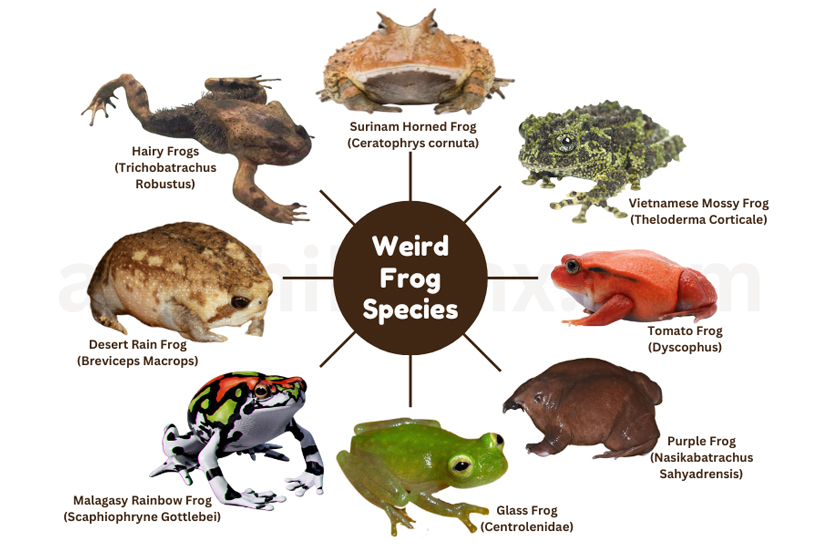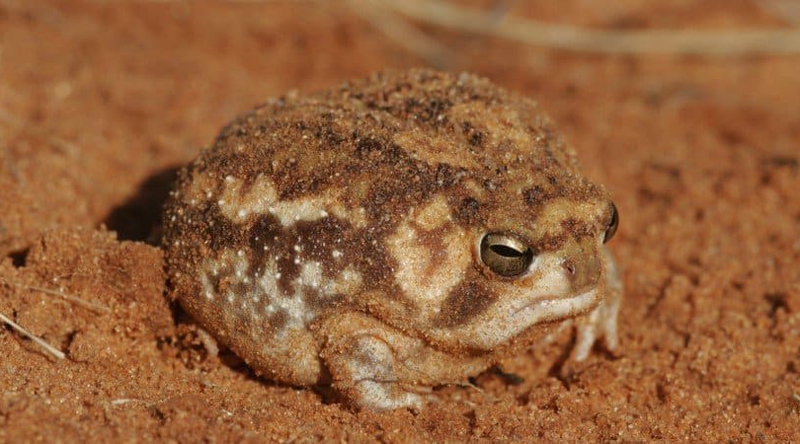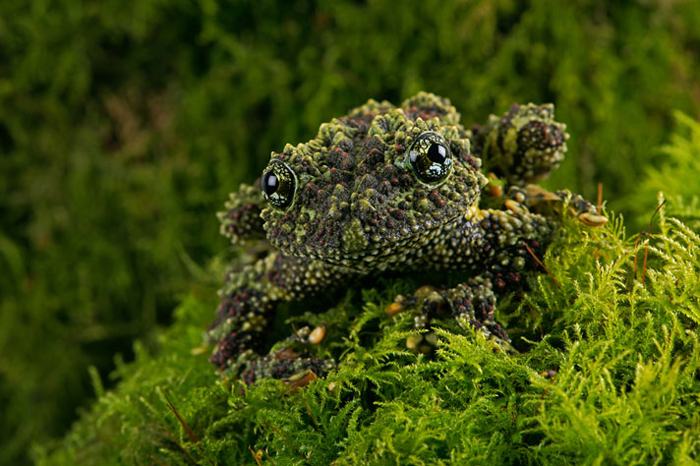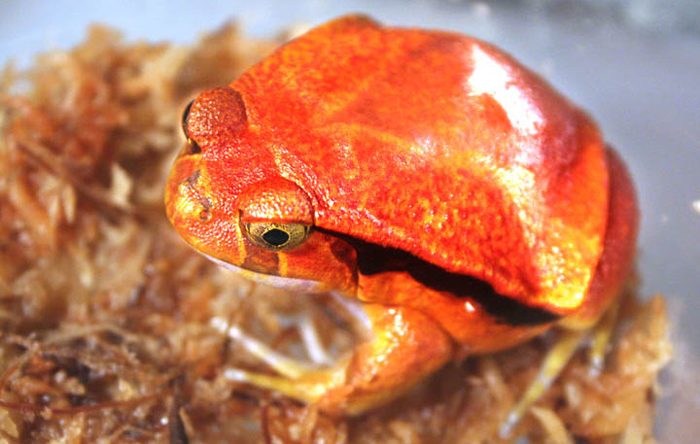Frogs are found all over the world, demonstrating their incredible capacity to survive in a variety of settings. You will spot them from the thick Amazonian jungle to the tranquil ponds of the countryside. And if you are a nature lover, you need to know some of their mysterious and bizarre kinds.
To let you know, we have listed 8 weird frog species. They are as follows:
- Surinam Horned Frog
- Malagasy Rainbow Frog
- Purple Frog
- Hairy Frogs
- Desert Rain Frog
- Glass Frog
- Vietnamese Mossy Frog
- Tomato Frog
Weird frogs have created a place for themselves, enthralling both scientists and nature lovers with their unusual traits. Let’s go on a journey to investigate the most mysterious world of frogs in the wild.
8 Weird Frog Species That You Need to Know

Here are the 8 frog species that will surprise you:
1. Surinam Horned Frog (Ceratophrys cornuta)
Did you ever wonder if a frog could have horns? The Surinam Horned Frog, also known as Ceratphrys, has this weird appearance. These captivating amphibians roam around the South American forest floor.

Physical Structure and Appearance
The Surinam Horned Frog stands out as a mysterious species in the wide world of frogs. Its stunning horn-like extensions above its eyes and its robust and powerful physique make it unique.
This frog has a fearsome look and personality to intimidate its competitors. These chubby amphibians can reach a length of 8 inches, which is large enough to cover a tea saucer. They weigh around 1.1 lbs.
Males have more elaborate coloring, ranging from lime to dark green, while females are often bigger and have tan color.
Weird/Unique Traits
As we mentioned before, the weird thing about the Surinam Horned frog is its horns-like objects on it.
It has a reputation for hunting prey bigger than its size, and its powerful jaws help it eat its kills. This frog eats fish, lizards, mice, and other frogs.
2. Malagasy Rainbow Frog (Scaphiophryne Gottlebei)
The fascinating amphibian Malagasy Rainbow Frog, taxonomically known as the Scaphiophryne Gottlebei, is indigenous to the island of Madagascar.

Physical Structure and Appearance
It’s a tiny, roundish frog species with vivid colors. The Malagasy Rainbow Frog has a unique white, orange-red, green, and black pattern on its back, with defined borders between each hue. The belly’s gray skin is a little rougher than the back’s, which is exceedingly smooth.
One distinctive trait is its capacity to expand its body, giving the impression that it is bigger and scaring off prospective predators. Male frogs typically grow to a size of 0.8 to 1.2 inches, and females grow 1.2 to 1.6 inches. Their weight is somewhere around 0.015 lbs.
Weird/Unique Traits
Surprisingly, both burrowing and rock climbing are well suited to this remarkable species. The species can avoid flash floods because they can climb. They emerge from their tunnels at night to hunt.
They are good hunters because they can scale tall walls. Its front limbs include claws that allow them to climb rock walls. They’ll conceal themselves in these walls’ tiny cracks and holes.
3. Purple Frog (Nasikabatrachus Sahyadrensis)
The Purple Frog, also known by its scientific name Nasikabatrachus sahyadrensis, is remarkable and secretive. This frog species lives in India’s Western Ghats mountain region.

Physical Structure and Appearance
The Purple Frog is a large, strong frog that is well-known for having unusual, primitive traits. It has a small, squat body with a rounded midsection, pointed arms, and short legs. The rich purple coloring that covers this frog’s whole body is its most noticeable feature. Purple frogs can grow up to 7 centimeters in length. Their weight is 0.363 lbs.
Weird/Unique Traits
It has silky and moist skin and can survive and flourish in its specialized subterranean home. They can cling to submerged rocks and boulders thanks to their flattened bodies, which essentially aid them in battling strong currents.
4. Hairy Frogs (Trichobatrachus Robustus)
Let us introduce the Horror Frog or Hairy Frog, scientifically known as Trichobatrachus Robustus.
The hairy frog is mostly found in Central and Western African wetland and tropical rainforest ecosystems. It prefers to live in and around wetlands and streams that are covered with trees.

Physical Structure and Appearance
The body of the hairy frog is quite strong and muscular, with males usually being bigger than females.
Males are roughly 10–13 cm, whilst females measure 8–11 cm. They weigh around 0.312 lbs.
Although the species’ females resemble conventional frogs, the males have DP on their sides and rear legs. Only during the frogs’ mating season do these papillae emerge.
Weird/Unique Traits
A frog with hair may be the most bizarre thing one can imagine. And the name shows that this frog has hairs on its body. The presence of projections that resemble hairs on its body is what sets it apart. These projections are modified dermal papillae rather than actual hair.
As opposed to the keratin that most other creatures’ genuine claws are composed of, their “claws” are constructed of bone. The frog may purposefully shatter the bones in its toes when threatened or assaulted.
This allows the creature’s bony, razor-sharp claws to thrust through the flesh, thus transforming its feet into powerful weapons. And this adaptation technique makes them powerful and intimidating foes in front of predators or prospective enemies.
5. Desert Rain Frog (Breviceps Macrops)
The little and endearing Desert Rain Frog lives in the arid areas of southwest Africa.

Physical Structure and Appearance
The body of the Desert Rain Frog is round, and it has short legs and a small snout. It is a small species, often only reaching a length of 4-6 cm, and weighs 0.025 lbs. Its pale yellow or brown skin serves as a great camouflage against the dunes.
The internal organs of the desert rain frog can be seen through a translucent patch of skin on its underside.
Weird Traits
The vocalization of the Desert Rain Frog is one of its most distinctive features. Its cry is incredibly powerful and unique despite its small size.
Desert rain frogs can’t hop; they only walk. The hands feature a single subarticular basal tubercle that is marginally developed. The limbs are short, about the size of the body. This makes them strong enough to walk.
6. Glass Frog (Centrolenidae)
Glass frogs belong to the Centrolenidae family. The cloud forests and tropical rainforests of Central and South America are the main habitats for glass frogs. They live in vegetation close to rivers and streams. They are very reliant on water supplies for breeding and egg-laying.

Physical Structure and Appearance
They are called “glass frogs” because of their transparent skin and appear as though they were made of glass. It aids the glass frogs in blending into their environment.
Their bodies deceive potential predators, so they mistake the surroundings for the frogs behind the glass. Glass frogs typically measure between 1.2 and 3.0 inches in length. Their weight remains between 0.012 lbs and 0.031 lbs.
Weird/Unique Traits
Their body structure and glass-like appearance are the things that make them unique. The majority of the time, glass frogs spend their days upside-down on transparent leaves that are the same color as their backs.
Here’s a video of a glass frog that should amaze you.
7. Vietnamese Mossy Frog (Theloderma Corticale)
Vietnam, Southern China, and South Central Laos are home to the Vietnamese Mossy Frog or Theloderma corticale. These frogs are highly intelligent because they will curl up into a ball and pretend to be dead when startled.

Physical Structure and Appearance
Vietnamese mossy frogs’ green appearance, black markings, and observable tubercles and spines closely resemble a clump of moss. They conceal themselves in water basins located in fissures, only sticking out their eyes to closely check their surroundings.
Because of this, they are nearly invisible when stationary. Males often being thinner and smaller than females. The Vietnamese mossy frog can reach a maximum size of 3.5 inches and weigh 0.088 lbs- 0.110 lbs.
Weird/Unique Traits
Their appearance, like clumps of moss, sets them apart from other frog species. They are weirdly beautiful.
Vietnamese mossy frogs are mostly arboreal, which means they spend most of their time in trees. These jumping tree frogs have sticky toe pads. The base of the inner finger of males has a distinct breeding callus.
To avoid danger or snag prey, these frogs can jump to astonishing lengths. Mossy frogs go after huge insects like cockroaches and crickets.
8. Tomato Frog (Dyscophus)
Dyscophus species, sometimes referred to as tomato frogs, are a bright and fascinating species of amphibians that are unique to Madagascar.

Physical Structure and Appearance
Their physique is thick and rounded, and their skin is silky and moist. They are known to have broad mouths and big eyes. These frogs spend most of their life hidden behind dirt and leaves.
They are toxic and can inflate themselves to frighten off predators. Female tomato frogs are typically slightly larger than males, and they can reach lengths of 2.5 to 3.5 inches. Females weigh 0.498 lbs and males weigh 0.093 lbs.
Weird Traits
These frogs are named after ripe tomatoes because of their vivid red or orange coloring.
The evening and nighttime hours are when tomato frogs are most active, and these hours are when you may hear their distinctive vocalizations. Tomato frogs have teeth which is not so common among frogs. They consume worms, insects, and insect larvae as food.
Exploring the quirkiest and most bizarre frogs certainly captivates the imagination. But for those who have been inspired to embark on their own amphibian adventures, there are traditional and modern methods to consider. Delve into the world of frog gigging, an age-old technique used for catching these creatures, especially at night. If you’re seeking a gentler approach, our guide on how to catch a frog provides step-by-step methods ensuring the well-being of both the frog and the handler.FAQs
Now that you know some weird frog facts, we will move on to answer some questions regarding frogs.
Frogs generally shed their skin weekly. Some frog species eat their old skin and others bury it.
Yes, they can. Frog mesotocin, like oxytocin in people and other animals, aids hairy frogs in feeling relaxed and comfortable in their surroundings.
Conclusion
In conclusion, each of these 8 weird frog species that you need to know has an amazing tale to share. Whether it is the hairy frog with a distinctive body feature or the glass frog with its translucent skin, these animals challenge our notions of what is “normal” in the animal realm.
Studying these unusual frogs not only broadens our knowledge of nature but also emphasizes how crucial conservation is. Many of these rare species are in danger of extinction due to challenges, including habitat loss, pollution, and climate change.

Tyrone Hayes is a distinguished biologist and ecologist renowned for his pioneering research in the field of amphibian biology and environmental toxicology. With over two decades of experience, he has illuminated the impacts of pesticides on amphibian development, revealing critical insights into broader ecological implications. Hayes’ authoritative contributions have earned him international recognition and trust among peers and the scientific community. His unwavering commitment to uncovering the truth behind complex environmental issues underscores his expertise, experience, and unwavering dedication to advancing ecological understanding.
